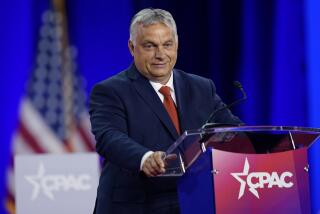MEDIA IN ACTION AT REYKJAVIK
- Share via
“Rarely does the payoff match the pomp,” Ted Koppel noted during a “Nightline” program on the eve of the Reykjavik, Iceland, meeting between President Reagan and Soviet leader Mikhail S. Gorbachev.
This time, however, the payoff was that there was no payoff, as Secretary of State George Schultz announced dramatically shortly after noon Sunday that those “extraordinary discussions” between Reagan and Gorbachev had ended in “great disappointment.”
Schultz’s Reykjavik comments were carried live by CBS, NBC and CNN. Where was ABC? Staying with its regularly scheduled telecast of the American League Championship game between the California Angels and Boston Red Sox.
Yes, first things first. In its great wisdom, ABC decided that doings in Anaheim were more critical to America than doings in Reykjavik. So much for priorities.
CBS and NBC ultimately left Schultz. Thank goodness for CNN, though, which also carried Schultz’s subsequent press conference until Gorbachev began a separate briefing of his own. CNN carried that live, too, before switching to the airport where Reagan was making some comments before leaving for home. Reagan was carried live also by CBS, and the merging of Soviet and American images on TV was striking.
As always, though, the media were their own message, showing up for the summit in such force that their mere presence conveyed enormous hope and optimism that words of moderation couldn’t dash.
Of course , big things would come from tiny Reykjavik. Why else would NBC’s Tom Brokaw, CBS’ Dan Rather and ABC’s Peter Jennings anchor their nightly newscasts from there, and why would CNN be omnipresent along with foreign TV and hordes of print press?
Yet the rhythms of TV often clash in curious ways.
From a viewer’s perspective, there was a calm over Reykjavik belying the summit’s obvious significance. Brokaw may have been right Saturday in calling the Reagan/Gorbachev meeting “historic.” Yet there seemed far more at stake a few minutes later on ABC when Len Dykstra hit a homer in the bottom of the ninth inning to give the New York Mets a 6-5 victory over the Houston Astros in the National League Championship Series.
The set seemed to shake as Dykstra’s homer cleared the fence and the Mets crowd exploded. The moment underlined the similarities between sports and national loyalties. Both feed on group identity, emotion and fervor.
On this day, however, the trench coats in Reykjavik--tackling issues that may determine the fate of humankind--could not match the roar of a baseball game.
Coverage of the Reykjavik summit followed the familiar American TV scenario:
Step 1: The networks discover Iceland and file reports about the country and its importance to Americans.
Step 2: TV speculates about what will be discussed and achieved at the summit.
Step 3: The summit begins.
Step 4: TV speculates about what is being discussed and achieved.
Step 5: The summit ends and the participants make statements.
Step 6: TV speculates about what was discussed and what was achieved.
Step 7: Everyone goes home and forgets about Iceland.
Reykjavik was at once the ultimate photo opportunity and an unfocused event blurred by a news blackout imposed by both sides until after the summit (although the Soviets appeared to have broken the blackout at least once).
Reporting goes on even during a blackout. Reporters lacking hard information resort either to interviewing each other or over-analyzing.
Earlier Sunday morning, Brokaw noted on NBC that a Reagan-Gorbachev meeting was lasting far longer than scheduled. “Whether that means anything in terms of success, we can’t say right now,” he said.
Viewers heard different on CNN, though, where national security expert Michael Vlahos in Washington resorted to blind guesswork while trying to explain why the meeting in Reykjavik was dragging on.
Lacking any information, he still speculated that Reagan and Gorbachev had “hit a snag they can’t resolve. When it goes beyond 15 minutes (longer than scheduled), especially in a hype situation like this,” continued Vlahos, “we should temper our optimism.”
And temper the guessing, too.
At 6:35 a.m., the two leaders finally emerged from their Hofdi House meeting and shook hands. Gorbachev got into his car and was driven off. Reagan waved goodby, then re-entered Hofdi House.
Cut to Vlahos, who this time proceeded to analyze Reagan’s and Gorbachev’s exit from Hofdi House. “Perhaps, given the body language of Gorbachev and Reagan, which was pretty positive, we might be watching . . . leaders . . . trying to get something done.” Ah, yes, the old body language issue.
Vlahos added that Reagan’s shrug “was not a negative shrug.” Well, that was good news.
Typical of such events, words were significant at Reykjavik, including the “public relations advantage” that Gorbachev was supposed to have gained by bringing his wife. It could be a “public relations advantage,” however, only if the media complied by following her everywhere she went. Which they did.
The dance continues.
More to Read
Go beyond the scoreboard
Get the latest on L.A.'s teams in the daily Sports Report newsletter.
You may occasionally receive promotional content from the Los Angeles Times.






